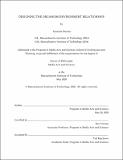| dc.contributor.advisor | Neri Oxman. | en_US |
| dc.contributor.author | Sharma, Sunanda,Ph. D.Massachusetts Institute of Technology. | en_US |
| dc.contributor.other | Program in Media Arts and Sciences (Massachusetts Institute of Technology) | en_US |
| dc.date.accessioned | 2020-09-15T22:00:57Z | |
| dc.date.available | 2020-09-15T22:00:57Z | |
| dc.date.copyright | 2020 | en_US |
| dc.date.issued | 2020 | en_US |
| dc.identifier.uri | https://hdl.handle.net/1721.1/127499 | |
| dc.description | Thesis: Ph. D., Massachusetts Institute of Technology, School of Architecture and Planning, Program in Media Arts and Sciences, May, 2020 | en_US |
| dc.description | Cataloged from the official PDF of thesis. | en_US |
| dc.description | Includes bibliographical references. | en_US |
| dc.description.abstract | How does one reconcile the complex uncertainties of living systems with the control required for real-world design? This is the central question facing the field of biological design and the creative intersection it occupies, seeking to move beyond the mimicry of biological processes and structures into the physical fabrication of biohybrid materials and products. In experimental biology, the variability of life is often intentionally stifled through the use of highly controlled environments and well-characterized materials and organisms. However, the resulting findings cannot easily be translated out of the lab in a physical setting, severely limiting the potential impacts of this field. The stakes for impactful science and design are becoming increasingly high, given the stark deterioration of the natural environment and the imminent exploration of extreme reaches, such as deep space. At this point in the history of science and design, we are fortunate to experience two extremes -- tools that allow for finer control than ever before possible, be it additive manufacturing, microscopy, or computational design -- and a wave of systems-level thinking that grapples with the overwhelming complexity and variation of nature. Building upon ideas from nonlinear dynamics, systems biology, architecture, and design, I present an experimental approach to biological design, which seeks to provide guidelines and achieve influence at large spatiotemporal scales and in dynamic environments while considering inherent stochasticity in living systems as a feature. I present five project areas, spanning multiple phyla, scales, and public venues, through which I develop and demonstrate the practice of Organism-Environment Design. | en_US |
| dc.description.statementofresponsibility | by Sunanda Sharma. | en_US |
| dc.format.extent | [xxvi], 422 pages | en_US |
| dc.language.iso | eng | en_US |
| dc.publisher | Massachusetts Institute of Technology | en_US |
| dc.rights | MIT theses may be protected by copyright. Please reuse MIT thesis content according to the MIT Libraries Permissions Policy, which is available through the URL provided. | en_US |
| dc.rights.uri | http://dspace.mit.edu/handle/1721.1/7582 | en_US |
| dc.subject | Program in Media Arts and Sciences | en_US |
| dc.title | Designing the organism-environment relationship | en_US |
| dc.type | Thesis | en_US |
| dc.description.degree | Ph. D. | en_US |
| dc.contributor.department | Program in Media Arts and Sciences (Massachusetts Institute of Technology) | en_US |
| dc.identifier.oclc | 1193026613 | en_US |
| dc.description.collection | Ph.D. Massachusetts Institute of Technology, School of Architecture and Planning, Program in Media Arts and Sciences | en_US |
| dspace.imported | 2020-09-15T22:00:57Z | en_US |
| mit.thesis.degree | Doctoral | en_US |
| mit.thesis.department | Media | en_US |
